Salalah
Salalah (Arabic: صَلَالَة, transliterated Ṣalālah) is the capital and largest city of the southern Omani governorate of Dhofar. Its population in 2009 was about 197,169.[1]
Salalah صَلَالَة | |
|---|---|
Street in Salalah in the early 2000s | |
| Nickname(s): Queen City of the South | |
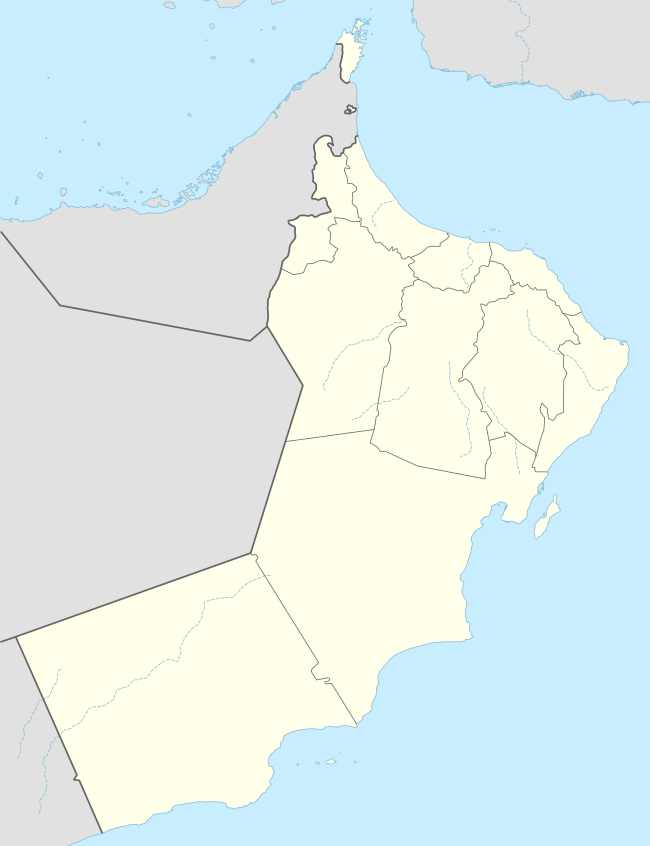 Salalah Location of Salalah in Oman | |
| Coordinates: 17°01′11″N 54°05′23″E | |
| Country | |
| Governorate | Dhofar |
| Government | |
| • Type | Absolute Monarchy |
| • Sultan | Haitham bin Tariq Al Said |
| Population (2016) | |
| • Metro | 340,815 |
| Time zone | UTC+4 (Oman standard time) |
| Website | www.beautifulsalalah.com |
Salalah is the third-largest city in the Sultanate of Oman, and the largest city in the Dhofar Province. Salalah is the birthplace of the former sultan, Qaboos bin Said. Salalah attracts many people from other parts of Oman and the Persian Gulf region during the monsoon/khareef season, which spans from June to September. The climate of the region and the monsoon allows the city to grow some vegetables and fruits like coconut and bananas. There are many gardens within the city where these vegetables and fruits grow.
History
Salalah was the traditional capital of Dhofar, which reached the peak of prosperity in the 13th century thanks to the incense trade. Later it decayed, and in the 19th century it was absorbed by the Sultanate of Muscat. Between 1932 and 1970, Salalah was the capital of the Sultanate of Muscat and Oman under Said bin Taimur. After the latter's overthrow, his son Qaboos decided to move the capital of Oman to Muscat.
The Sultan traditionally lives in Salalah rather than in Muscat, the capital and largest city in Oman, but Qaboos has bucked this trend, and has lived in Muscat since he ascended to the throne in 1970. He does, however, visit Salalah fairly regularly to meet with influential tribal and local leaders; his last visit was in 2010 and before that he visited in 2006.
In 2010, during the 40th anniversary of Sultan Qaboos' taking the throne, he decided to spend his time in Salalah. The 40th anniversary celebrations consisted of a massive parade. It lasted several hours and had an estimated 100,000 attendees. In 2011 the city hosted peaceful protests after the domino effect from the Arab Spring which lasted several months. Of the many requests filed from the protesters, some included the expulsion of the current ministers, job opportunities, salary increases, a solution to the increasing cost of living, and the establishment of Islamic banks.
City districts and suburbs
- Al-Dahariz
- Al-Haffa
- Al-Mughsail
- Al-Mutaaza
- Al-Saada
- Al-Wadi
- Auqad
- City Center
- Eastern Salalah
- Ittin
- New Salalah
- RaysRays
- Western Salalah (also known as Al-Gharbia, and Al-Gantra)
Climate
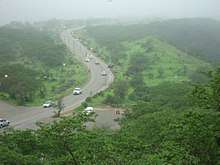
The city has a hot desert climate (Köppen climate classification BWh), although summers are cooler than in more northern or inland parts of Oman. Salalah is very cloudy and foggy during the monsoon months of July and August, even though relatively little rain falls. Khareef means "autumn" in Arabic but it refers to monsoon when describing the region around Salalah. During this time, the brown landscape of Salalah and its surroundings is completely transformed to a beautiful and lush greenery.
Cyclone Mekunu, which originated over the Arabian Sea, became an extremely severe cyclone before hitting the Salalah city on 25 May 2018. 200 kmph was the recorded windspeed, and the city of Salalah was pounded with over 617 mm (24.3 in) of rainfall, which is almost 5 years of Oman's average rainfall.
| Climate data for Salalah | |||||||||||||
|---|---|---|---|---|---|---|---|---|---|---|---|---|---|
| Month | Jan | Feb | Mar | Apr | May | Jun | Jul | Aug | Sep | Oct | Nov | Dec | Year |
| Record high °C (°F) | 32.3 (90.1) |
33.8 (92.8) |
36.7 (98.1) |
43.6 (110.5) |
42.3 (108.1) |
43.0 (109.4) |
32.7 (90.9) |
31.3 (88.3) |
33.0 (91.4) |
40.1 (104.2) |
37.4 (99.3) |
34.2 (93.6) |
43.6 (110.5) |
| Average high °C (°F) | 27.5 (81.5) |
27.9 (82.2) |
29.9 (85.8) |
31.7 (89.1) |
32.4 (90.3) |
31.8 (89.2) |
28.4 (83.1) |
27.3 (81.1) |
29.0 (84.2) |
30.5 (86.9) |
30.8 (87.4) |
28.7 (83.7) |
29.7 (85.4) |
| Daily mean °C (°F) | 22.9 (73.2) |
23.7 (74.7) |
25.5 (77.9) |
27.6 (81.7) |
29.0 (84.2) |
29.0 (84.2) |
26.4 (79.5) |
25.2 (77.4) |
26.3 (79.3) |
26.3 (79.3) |
25.9 (78.6) |
23.9 (75.0) |
26.0 (78.7) |
| Average low °C (°F) | 17.9 (64.2) |
19.2 (66.6) |
21.0 (69.8) |
23.4 (74.1) |
25.6 (78.1) |
26.5 (79.7) |
24.2 (75.6) |
23.1 (73.6) |
23.4 (74.1) |
21.6 (70.9) |
20.4 (68.7) |
18.8 (65.8) |
22.1 (71.8) |
| Record low °C (°F) | 12.6 (54.7) |
10.8 (51.4) |
14.5 (58.1) |
18.0 (64.4) |
20.6 (69.1) |
23.5 (74.3) |
21.9 (71.4) |
20.5 (68.9) |
19.1 (66.4) |
16.5 (61.7) |
15.0 (59.0) |
14.1 (57.4) |
10.8 (51.4) |
| Average precipitation mm (inches) | 2.2 (0.09) |
7.0 (0.28) |
6.3 (0.25) |
19.8 (0.78) |
17.1 (0.67) |
10.6 (0.42) |
24.6 (0.97) |
24.5 (0.96) |
4.1 (0.16) |
4.1 (0.16) |
9.6 (0.38) |
1.1 (0.04) |
131 (5.16) |
| Average relative humidity (%) | 50 | 58 | 62 | 68 | 75 | 80 | 89 | 90 | 81 | 67 | 55 | 50 | 69 |
| Mean monthly sunshine hours | 289.6 | 256.8 | 297.6 | 308.3 | 335.1 | 199.5 | 43.9 | 42.4 | 188.0 | 314.7 | 304.7 | 296.8 | 2,877.4 |
| Source: NOAA (period of record varies, see source)[2] | |||||||||||||
Demographics
Religion
The city, like many other in Arab states of the Arabian peninsula, has a relatively large expatriate community, mainly from India, Pakistan, Bangladesh and Philippines.
The majority of the Omani population in Salalah is Muslim. Like the majority of the Middle East, most people in Salalah follow the Sunni Shafi sect of Islam; unlike the majority of Omanis in Muscat which mostly follow the Ibadhi sect. There is also a considerable population of Hindus, Christians, Buddhists and Sikhs in the expatriate community.
Language
Arabic is the official language and the most spoken one. The unofficial, unwritten language known as Jeballi is the second most spoken language and the mother tongue of many in Salalah and its surrounding areas, with 25,000 estimated speakers as of 1993.[3]
English is the official foreign language and the most spoken language of the expats. Malayalam is another popular language and together with Tamil, Telugu, Hindi/Urdu it is the most widely spoken language among expatriates.
Economy
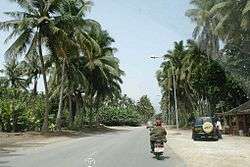
APM Terminals, part of the A. P. Moller-Maersk Group of Denmark, manages the Port of Salalah; one of the largest ports on the Arabian Peninsula which is an important transshipment hub for container shipping in the area. The Port of Salalah is also one of the most vital ports on the peninsula connecting together Africa, the Middle East, and Asia. But the port is outside the city, to the south. It is also the largest private employer in the Dhofar region. The Salalah Free Zone, situated right beside the port, is emerging as a new center for heavy industries in the Middle East.
Tourist attractions
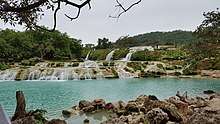
Salalah's economy is also based on Tourism. During the Khareef season (June to September), many tourists visit from Middle East. There are many places to visit in Salalah during this season as the mountains turns green and the rain causes many waterfalls in the mountains, mainly in Wadi Darbat, Ain Athum, Ain Tubrook, and Ain Khor [4]. There are four tombs reported to belong to prophets located here: Nabi Imran, Nabi Ayoob, Nabi Houd, and Nabi Salih.[5] The city received more than 600,000 tourists during the khareef season in 2017.[6] There are a number of cultural events in Dhofar Governerate which attract visitors, including the Salalah carnival which includes family activities, concerts, rides, cultural activities and vendors.
Sports

Salalah is known as the home of some of the best football clubs in Oman. In total, Salalah has 4 sport clubs based in the city: Salalah Club, Al-Ittihad, Al-Nasr, and Dhofar.
Dhofar F.C. have been nicknamed as "Al-Zaeem", or "The Leaders", due to their enormous success in both the Omani League, and in the Sultan Qaboos Cup. Dhofar have also have an adequate number of trophies in sports like volleyball, and handball. Al-Nasr have also been known for their great success in football, winning the Omani League 5 times, and the Sultan Qaboos Cup 4 times. Al-Nasr, like Dhofar, have also been successful in other sports such as hockey, basketball, volleyball, and handball.
Salalah currently has 2 stadiums, the Salalah Sports Complex (also known as the "Youth Sports Complex"), which is the only multi-purpose stadium in Salalah. The newer, Al-Saadah Stadium is the newly built stadium in Al-Saada district of Salalah devoted to football. Incorporated in the walls of the sports complex apart from the football stadium is a hockey field, tennis court, olympic swimming pool, and indoor volleyball/basketball court. Al-Saada Stadium is the venue where Saudi national football team, and the Omani national team first met in Salalah on August 12, 2009.
The most popular sport played among the youth is by far football. It is very normal to see a group of boys and young men from around the area playing in makeshift fields in parking lots, or in a large open area. Beach football is also a common sight to see along the beach in the Al-Haffa district. Another popular sport in Salalah is volleyball. Although not as popular as football the game is frequently played.
Education
Currently Salalah has two colleges, the Salalah College of Technology and Salalah College of Applied Science, both of which are government owned and sponsored.
The Salalah College of Applied Sciences incorporates an English Department. Its aim is to offer students a solid grasp of the English language so that they may go on to complete further studies in important sectors such as I.T. and Communication and Design.
Salalah is also home to a private university, Dhofar University which is one of the largest in the region. It has significant shares owned by Mustahil Al-Mashani, uncle of Sultan Qaboos bin Said. Recently the university has constructed a new campus worth 25 million OR.[7]
The Indian School Salalah is an Indian-run, self-financing, co-educational institution, primarily established to meet the academic needs of children of Indian expatriates working in Salalah. The Indian School Salalah is the largest English-medium school in Salalah and it also admits children of other nationalities. The school is located in the North Dahariz area, of Salalah town.
Pakistan School Salalah is a Pakistani Co-educational High school which was established in the year 1982. The school is situated adjacent to the Indian School in Salalah Dahariz north.
British School Salalah was founded in 1970. The school follows the National Curriculum of England and Wales, and offers schooling to children from Reception to Year 9. It is also situated in Dahariz next to the Indian School and Pakistani School.
Transportation
Air transport
Salalah International Airport mainly caters to domestic flights from Muscat and some International flights from India and regional Arab countries such as Qatar, U.A.E, and Saudi Arabia. Oman Air, the national airline operates 5 flights daily from Salalah to Muscat, the capital city and also 2 flights to Dubai weekly. Oman Air introduced Oman Air Pass for regular travelers between Salalah and Muscat.[8] Qatar Airways has daily flights from Salalah to Doha connecting to over 130 destinations worldwide. Very convenient connections are available to destinations in Europe, the Americas, Africa, Asia and Australia. There is also a direct weekly flight from and to Kochi, Kozhikode (Calicut) & Thiruvananthapuram operated by Air India Express for the Malayalee expatriates. During the Khareef Season (Monsoons) there are weekly flights to other international destinations including Sweden and Turkey. There are also transit flights to almost all countries. The new International airport opened on 15 June 2015 [9] and the old Airport has since then been converted into a Domestic and emergency Airport.
Bus
There is a daily bus service from Deira, Dubai, UAE to Salalah at 3pm.[10] There is daily bus service between Muscat and Salalah from many bus service providers.
Public transport
Salalah did not have a public transportation system within the city limits until 2018, but in 2019 Sultan Qaboos announced a bus service within the city from Salalah airport to city center and city center to Salalah port.
Oman National Transport Company (Mwasalat) has started daily public bus service in Salalah from December 2018 [11]
long distance air-conditioned buses are operated daily from Salalah to Haima, Muscat, Nizwa, Al-Buraimi, Dubai, Al-Ain, Al-Ghaydah, Mukalla, and Seiyun, as well as PDO locations such as Marmul.
Other forms of public transport popular in Salalah are taxis. Generally fares vary from half a Rial to 2 Rials depending on the distance to destination. Taxis are color-coded orange and white and provide semi-personal transportation in the form of both individual hire and the same opportunistic roadway service as Baisa buses, which are not as popular in the city.
Baisa buses, also colour-coded orange and white, and like taxis are unmetered after several government initiatives to introduce meters were rejected. The fare is set by way of negotiation, although drivers usually adhere to certain unwritten rules for fares within the city. One should always find out the normally accepted fare for one's journey from one's hotel or host before looking for a taxi.
Water transport
The Port of Salalah is one of the deepwater ports in Oman and also 11th busiest transshipment port in the world, second busiest port in middle east, which is located at Port Raysut(Salalah). It can accommodate large vessels up to 18m draft. It is the main Container Tran-shipment Terminal of the region. This port is operated and managed by Salalah Port Services Company (S.A.O.G.). The port also welcomes cruise liners & luxury ships.
Media
The English language radio stations are Hi FM and Merge, which are the only English language stations in Oman. There are also a number of Arabic radio channels. In Salalah almost all TV channels are available.
Projects
Project GreenOman, a project initiated to develop Eco-friendliness in Oman by Mast.Hridith Sudev, a student of Indian School Salalah and his younger brother, Samved Shaji won the World Environment Day Global School Contest conducted by United Nations Conference on Sustainable Development and Ecology & Environment Inc. This success brought glory to Indian School Salalah and this city making Salalah more popular as a green city.[12] In 2014, International Energy Globe Award, Austria declared Project GreenOman as Oman's best project for sustainability.
Gallery
 Satellite view of Salalah
Satellite view of Salalah12.jpg) Al-Baleed Archaeological Park
Al-Baleed Archaeological Park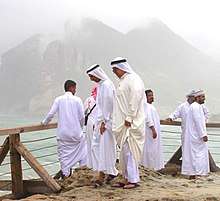 The coast at Al-Mughsayl
The coast at Al-Mughsayl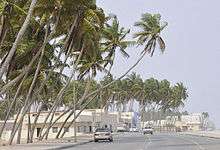 Al Hafa Corniche, near Salalah
Al Hafa Corniche, near Salalah- Frankincense sold in Salalah
See also
References
- "World Gazetteer: Şalālah – profile of geographical entity including name variants". Archive.is. Archived from the original on 8 December 2012. Retrieved 22 November 2013.CS1 maint: BOT: original-url status unknown (link)
- "Salalh Climate Normals". National Oceanic and Atmospheric Administration. Retrieved 16 January 2013.
- "Shehri". Ethnologue. 19 February 1999. Retrieved 22 November 2013.
- "Top 10 Places to Visit in Salalah".
- "Salalah Places to Visit".
- "Oman tourism: Khareef Salalah visitor numbers cross 600,000 mark". Retrieved 21 December 2017.
- "Dhofar University campus construction contracts reach RO 25 million". Du.edu.om. Archived from the original on 16 October 2012. Retrieved 22 November 2013.
- "Oman Air Introduces The New Oman Air Pass". Oman Air. 30 November 2016. Retrieved 28 July 2017.
- Hussain (20 May 2019). "Know All About New Salalah Airport Oman | Restaurants, Lounges, Duty Free". Travel with Hussain. Retrieved 2 June 2019.
- "Gulf Transport Company Bus between UAE & Oman". Travel with Hussain. Retrieved 18 December 2018.
- "Salalah Public Bus Service - Mwasalat". Travel with Hussain. 26 December 2018. Retrieved 2 June 2019.
- "IIS7". Projectearth.net. Archived from the original on 14 November 2013. Retrieved 22 November 2013.
External links
| Wikimedia Commons has media related to Salalah. |
| Wikivoyage has a travel guide for Salalah. |